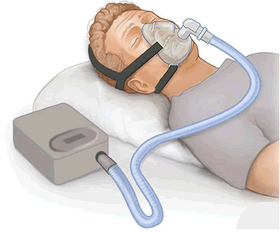Positive airway pressure
| Positive airway pressure | |
|---|---|
| Intervention | |

CPAP therapy: flow generator, hose, full face mask
|
Positive airway pressure (PAP) is a mode of respiratory ventilation used in the treatment of sleep apnea. PAP ventilation is also commonly used for those who are critically ill in hospital with respiratory failure, in newborn infants (neonates), and for the prevention and treatment of atelectasis in patients with difficulty taking deep breaths. In these patients, PAP ventilation can prevent the need for tracheal intubation, or allow earlier extubation. Sometimes patients with neuromuscular diseases use this variety of ventilation as well. CPAP is an acronym for "continuous positive airway pressure", which was developed by Dr. George Gregory and colleagues in the neonatal intensive care unit at the University of California, San Francisco. A variation of the PAP system was developed by Professor Colin Sullivan at Royal Prince Alfred Hospital in Sydney, Australia, in 1981.
The main indications for positive airway pressure are congestive heart failure and chronic obstructive pulmonary disease. There is some evidence of benefit for those with hypoxia and community acquired pneumonia.
PAP ventilation is often used for patients who have acute type 1 or 2 respiratory failure. Usually PAP ventilation will be reserved for the subset of patients for whom oxygen delivered via a face mask is deemed insufficient or deleterious to health (see CO2 retention). Usually, patients on PAP ventilation will be closely monitored in an intensive care unit, high dependency unit, coronary care unit or specialist respiratory unit.
...
Wikipedia
